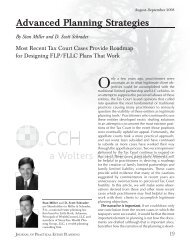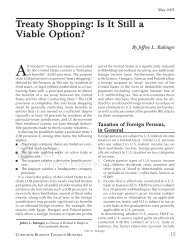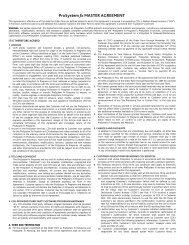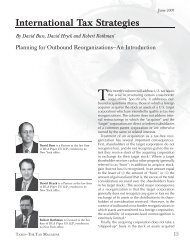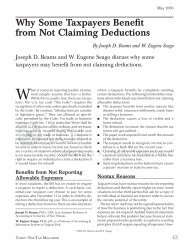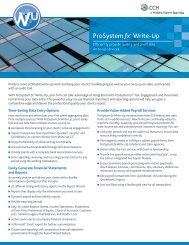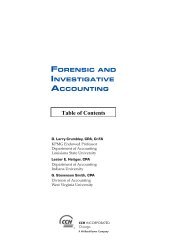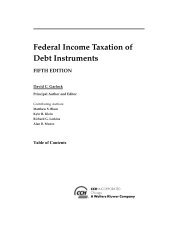The Art of Preparing a Successful Written Protest By William P ... - CCH
The Art of Preparing a Successful Written Protest By William P ... - CCH
The Art of Preparing a Successful Written Protest By William P ... - CCH
You also want an ePaper? Increase the reach of your titles
YUMPU automatically turns print PDFs into web optimized ePapers that Google loves.
April–May 2008the beholder. Glass made ornate with jewels willdraw to itself a part <strong>of</strong> the attention, and thus impairinterest in the view. <strong>The</strong> best window-glassis plate, a strong and highly finished product soclear that one looking through it is unconscious<strong>of</strong> its presence. 21Let’s consider the following illustration to reinforcethe point about planning and preparation. If you wereplanning a trip to a city located a thousand miles fromyour home, would you simply get into your car andstart driving? Not likely! Most <strong>of</strong> us would prepare anitinerary, prepare a list <strong>of</strong> items to bring with us, andchart our course by using a roadmap. In other words,we would spend a fair amount <strong>of</strong> time planning thetrip before starting the engine.Likewise, before you start to write a protest, taketime to organize your thoughts. Prepare a rough outline,a roadmap. Although different structures existfor preparing a written protest, the following topicalheadings are customary:Issue(s)Proposed Adjustment(s)FactsLawIRS ExaminationArgumentConclusionnUnder each <strong>of</strong> these headings, develop subheadings.ngs.For example, let’s assume that one <strong>of</strong> the issuesraised by the examining ng agent involves excessiveescompensation. Under the Facts heading, howwouldyou organize your presentation? Would you have asubheading focusing on the biographical descriptions<strong>of</strong> key employees? Would you have anothersubheading describing the company and the nature<strong>of</strong> its business? Would you have yet another subheadingdealing with financial data about compensationpaid to key employees?<strong>The</strong>se are the types <strong>of</strong> questions you must ask andanswer before you begin to write. Otherwise, yourpresentation will be confusing at best, incoherent atworst. In the end, it doesn’t matter how you organizethe different components <strong>of</strong> your written protest; whatmatters is that you have a plan for structuring andorganizing your protest (a roadmap), and that you usethis plan consistently throughout your presentation.Finally, remember that a good presentation requiresmore that good planning and organization. It alsorequires good writing. Bad writing is distracting. Itdistorts what otherwise might be a fine product. Foran AO who knows the rules <strong>of</strong> grammar, it is highlyannoying to see fundamental grammatical errors ina <strong>Protest</strong>. Beyond the annoyance factor, however, isa far more serious problem. Bad writing has the potential<strong>of</strong> diverting the AO’s attention from the pointyou are trying to make. What to do? <strong>Successful</strong> andaccomplished writers have a good handbook at theirsides whenever they write. As you prepare your writtenprotest, have a handbook at your side. If you areunsure about the punctuation <strong>of</strong> a particular sentence(e.g., do these sentence parts call for a comma or asemicolon), look it up. Don’t guess.Focus on FactsRegardless <strong>of</strong> what factual information you decideto include under each topical heading and subheading,you must also determine the order in which topresent the facts. Consider the following illustration.If you plan to drive from Boston to Chicago, it is unlikelythat you would drive first to Baltimore, then toNashville and finally to Chicago, unless <strong>of</strong> course timeand money were <strong>of</strong> no concern. Likewise, an AO willexpect to see some logical order to the presentation <strong>of</strong>the facts in your written <strong>Protest</strong>. Don’t confuse the AOby driving from Boston to Chicago via Nashville!Fortunately, a variety <strong>of</strong> techniques exist for orderingthe presentation <strong>of</strong> facts: there is the chronologicalapproach (e.g., emphasizing the timing and sequence<strong>of</strong> key events); there is the biographical approach(e.g., describing key individuals along with facts associatedwith them); and there is the transactionalapproach ach((e.g., e g focusing on the transfer <strong>of</strong> resourcesfrom one taxpayer to another). Again, it doesn’t matterwhat approach you use in ordering the presentation <strong>of</strong>facts in your protest; what matters is that you have anapproach and you employ it consistently throughoutyour presentation.Your statement <strong>of</strong> facts should also tell your client’sstory. James W. McElhaney makes the following pointin his article, “Humans always have used the story tounderstand facts and resolve issues. Everything in thelaw is a story. Every case, every motion, every brief isa story. <strong>The</strong> winning brief needs to tell a persuasivestory. Lots <strong>of</strong> thoughtful judges admit they start to takesides—lean one way or another—as soon as they readstatements <strong>of</strong> facts. <strong>The</strong> statement <strong>of</strong> facts is the mostimportant part <strong>of</strong> the brief because it points the wayto elemental justice.” 22According to McElhaney, there are lots <strong>of</strong> ways towrite a statement <strong>of</strong> facts; however, a good statementpasses two essential tests.JOURNAL OF TAX PRACTICE & PROCEDURE 41







